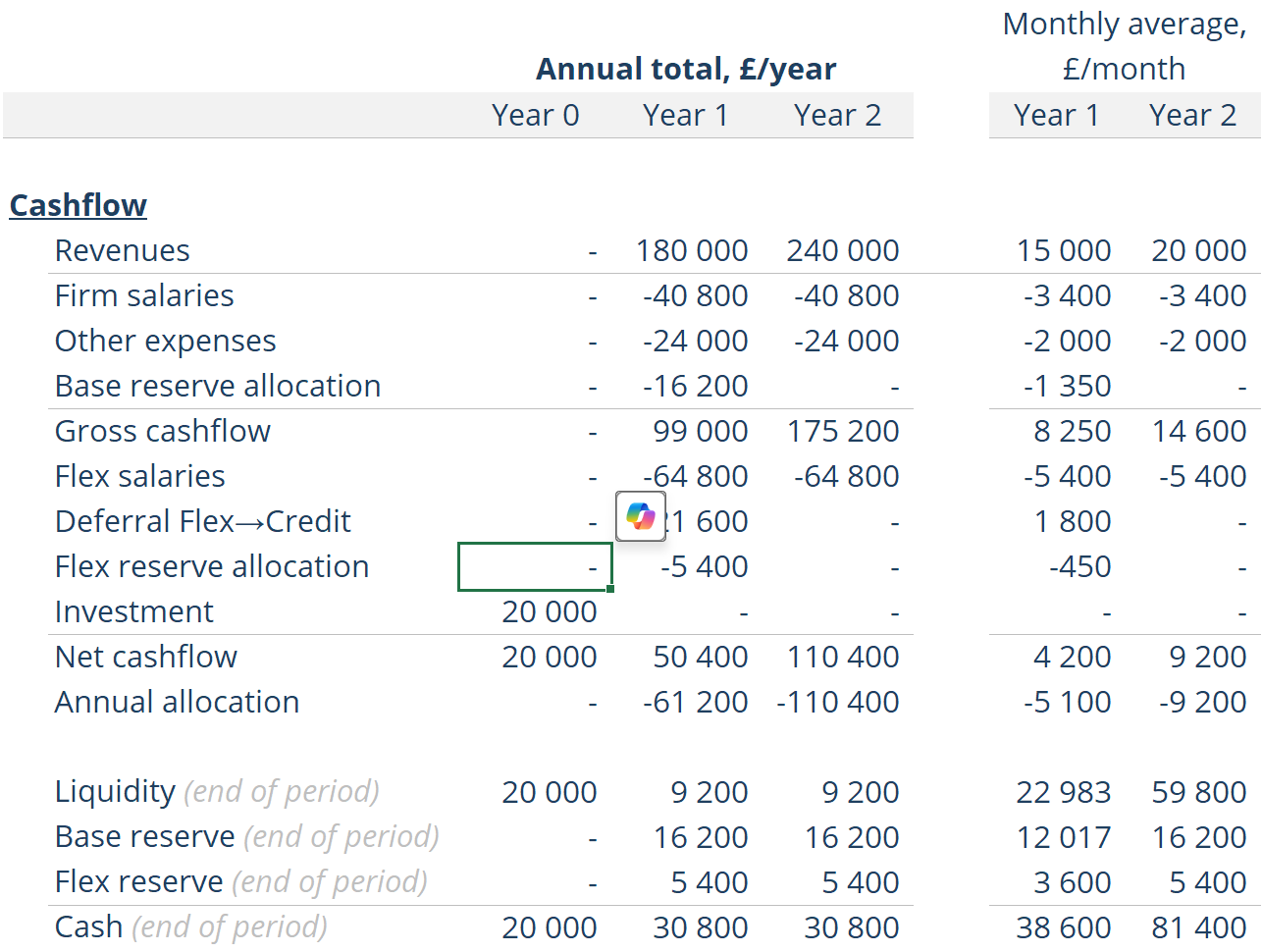Rebecca, a seasoned web designer in the UK, set out to launch her own agency alongside two junior colleagues, despite limited initial funds. With £60,000 in contracts ready and only £20,000 in savings, she used the FlexUp model to create fair, transparent contracts that balanced firm payments, flexible compensation, and equity-building credit — allowing each team member to share both risk and upside.
Over two years, the agency grew sustainably, achieved profitability, and distributed over £100,000 to the team — repaying deferred payments and building long-term equity. FlexUp enabled the team to manage cashflow with confidence, maintain motivation, and build shared ownership from the ground up. Today, the agency continues to thrive and expand using the same collaborative foundation.
🔎 Highlights
- Type: ✅ Simulated case study
- Country: United Kingdom
- Project type: web agency
- Team size: 3 – Rebecca + 2 junior colleagues
- Associates: same
- Legal structure: Dedicated legal entity owned by Rebecca
Context
Rebecca is an experienced web designer based in the UK, previously employed at a reputable agency. She wants to start a new agency with two of her junior colleagues, Kate and Andrew.
She has an extensive network of potential clients and has about 60 000 £ of contracts ready to sign. She thinks these projects would take about 3~6 months to be completed and fully paid. After that, she thinks that she can get about 240 000 £ per year of revenues with this team.
Rebecca’s current salary is 6 000 £ per month, and she has about 20 000 £ cash in savings. That’s enough to cover her living costs for the next 6 months, but not enough to pay her team a full salary at fair market value, which would be about 3 000 £ per month each.
Rebecca decides to use the FlexUp system to offer her colleagues a simple, fair and transparent deal.
Deal structure
She offers Kate and Andrew to hire them with a target salary of 3 000 £, of which:
- 1 200 £ paid in cash (40% Firm)
- 1 200 £ paid as a flexible remuneration (40% Flex)
- 600 £ invested in the project (20% Credit)
Rebecca would pay herself a target salary of 6 000 £ per month, of which:
- 1 000 £ paid in cash (16.7% Firm)
- 3 000 £ as flexible remuneration (50% Flex)
- 2 000 £ invested directly in the project (33.3% Credit)
The “Flex” tranche would only be paid if the project has enough available cash at the end of the month. If not, it would be converted in “Credits”, to be paid on an annual basis when the project becomes profitable.
Kate and Andrew believe in the success of the project, and have some savings of their own, so they accept to join her in this new endeavour.
Outcome
After six months, Rebecca’s agency successfully delivered the initial projects worth 60 000 £. She has put aside 30 000 £ in the “reserves” (required to cover future expenses) and has already started to pay the Flex remuneration in full.
By the end of the first year, the agency had generated 180 000 £ of revenues and reached profitability. Rebecca, Kate, and Andrew were able to recover the majority of their deferred Flex and Credit payments through the annual resolution process.
By the end of the second year, Rebecca was able to distribute over 100 000 £ to herself and the team, to fully repay the credits accumulated in the first years and distribute the excess profits. As part of FlexUp’s commitment to support the greater society and the environmental, she also gave over 10 000 £ as endowments to support local community initiatives.
Rebecca provided the greatest contribution and assumed the highest level of risk. Accordingly, her equity stake is the most substantial. Kate and Andrew also built up a significant stake, proportionate to their risk and effort. The result: a sustainable, resilient, and highly motivated team with shared governance and long-term commitment to the business.
Here’s a summary of the cashflows over the first 2 years:

On average, by the end of year 2, the team earned 40% more than their target remuneration, with a equitable distribution of the profits generated:

Here is the equity structure (credits + token) at the end of year 2, after the annual resolution and credit buyback process:

Conclusion
Despite the modest starting budget, careful cash flow management and the transparent FlexUp model helped ensure the team’s sustained motivation and clarity over remuneration.
The agency used FlexUp to:
- Record and track all contracts, orders, and deliveries
- Generate all related documentation and invoices
- Transparently allocate cash, and defer flexible payments
- Issue Credits and Tokens for unpaid flexible remuneration
- Run monthly and annual cash resolutions
Kate and Andrew also built up a significant equity stake in the project, aligned with their respective risk and effort contributions. The result: a sustainable, resilient, and highly motivated team with shared governance and long-term commitment to the business.
Today, the agency continues to grow, with Rebecca planning to onboard new clients and collaborators using the same FlexUp framework that helped launch the company. She’s also thinking about using the FlexUp model in her contracts with her key clients to get them to fund her growth in exchange for equity and thus creating long-term alignment with them.
🔗 Explore further
- 📖 Read the full story in our blog – Rebecca Web Agency
- 📄 Download the full case study – Rebecca Web Agency.pdf
- 📊 Download the financial model – Rebecca Web Agency BP 2025-10-06.xlsx
- 🧪 Log into our demo site to view this use case in the FlexUp app:
- Link: demo.flexup.app/login
- Email: agency@example.com
- Password: demo
Read other case studies
Rebecca Web Agency